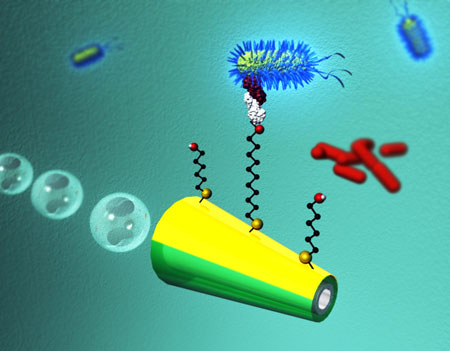Synthetic Nanomotors: Tiny Machines Powering the Future of Nanotechnology
Introduction to Synthetic Nanomotors
Synthetic nanomotors are tiny machines, typically in the range of nanometers to micrometers, that can convert various forms of energy into mechanical motion at the nanoscale. These artificial motors are inspired by the naturally occurring molecular motors found in biological systems, such as the motor proteins involved in muscle contraction and cell division. Synthetic nanomotors hold immense potential for revolutionizing diverse fields, including drug delivery, environmental remediation, and nanorobotics.

Propulsion Mechanisms
Synthetic nanomotors can be powered by various mechanisms, depending on their design and the energy source utilized. Some common propulsion mechanisms include:
Self-Electrophoresis
Self-electrophoretic nanomotors consist of two segments with different electrochemical potentials. When placed in a fuel solution, such as hydrogen peroxide, the catalytic segment generates a localized electric field, causing the nanomotor to move in the direction of the non-catalytic segment. This propulsion mechanism is highly efficient and can be controlled by external electric fields.
Bubble Propulsion
Bubble-propelled nanomotors rely on the generation of gas bubbles to drive their motion. These motors typically have a catalytic surface that decomposes a fuel, such as hydrogen peroxide, producing oxygen bubbles. The asymmetric release of bubbles creates a thrust force, propelling the nanomotor forward. Bubble propulsion is a powerful mechanism that can enable high-speed motion and cargo transport.
Acoustic Propulsion
Acoustically-driven nanomotors harness the energy of ultrasound waves to generate propulsion. These motors often have asymmetric shapes or surface functionalities that interact with the pressure gradients created by the ultrasound field. Acoustic propulsion offers the advantage of remote and wireless control, making it suitable for in vivo applications.
Materials and Fabrication
Synthetic nanomotors can be fabricated from a wide range of materials, including metals, polymers, and inorganic nanoparticles. The choice of material depends on the desired functionality, biocompatibility, and propulsion mechanism. Some commonly used materials include:
- Platinum: Platinum nanoparticles are widely used as catalytic segments in self-electrophoretic and bubble-propelled nanomotors due to their high catalytic activity towards hydrogen peroxide decomposition.
- Gold: Gold nanostructures are employed in acoustic nanomotors and as non-catalytic segments in bimetallic nanomotors. Gold surfaces can also be functionalized with biomolecules for targeted drug delivery applications.
- Polymers: Polymeric materials, such as polypyrrole and polyaniline, are used in the fabrication of flexible and biocompatible nanomotors. These materials can be easily modified with functional groups and respond to external stimuli, such as pH and temperature changes.
The fabrication of synthetic nanomotors involves various techniques, including template-assisted synthesis, self-assembly, and top-down fabrication methods like electron beam lithography and focused ion beam milling. These techniques allow for precise control over the size, shape, and composition of the nanomotors.
Applications of Synthetic Nanomotors
Synthetic nanomotors have diverse applications across different fields, leveraging their ability to perform complex tasks and navigate in various environments. Some key applications include:
Drug Delivery
Nanomotors can be designed to transport therapeutic payloads, such as drugs, proteins, or nucleic acids, to specific target sites in the body. The precise control over their motion and the ability to respond to external stimuli make nanomotors promising candidates for targeted and controlled drug release, minimizing side effects and enhancing treatment efficacy.
Environmental Remediation
Synthetic nanomotors can be deployed for the removal of pollutants and contaminants from water and soil. Catalytic nanomotors can degrade organic pollutants, while magnetic nanomotors can adsorb and remove heavy metal ions. The self-propelled nature of nanomotors allows them to actively seek out and eliminate pollutants, improving the efficiency of environmental cleanup processes.
Biosensing and Diagnostics
Nanomotors can be integrated with biosensing elements, such as antibodies or aptamers, to detect specific biomarkers or pathogens. The motion of the nanomotors can enhance the interaction between the target analytes and the sensing components, leading to improved sensitivity and faster response times. Nanomotor-based biosensors have potential applications in point-of-care diagnostics, food safety monitoring, and environmental surveillance.
Challenges and Future Perspectives
Despite the remarkable progress in the field of synthetic nanomotors, several challenges need to be addressed for their widespread practical implementation. One major challenge is the biocompatibility and biodegradability of the materials used in nanomotor fabrication. Developing nanomotors that are safe for in vivo use and can be eliminated from the body after completing their task is crucial for biomedical applications.
Another challenge lies in the control and navigation of nanomotors in complex environments, such as the human body or contaminated water. Advanced imaging and tracking techniques, along with the integration of external guidance systems, such as magnetic fields or ultrasound, are being explored to overcome this hurdle.
Future research in synthetic nanomotors will focus on developing more efficient and versatile propulsion mechanisms, expanding the range of materials and functionalities, and exploring new applications in areas such as nanoscale manufacturing, nanorobotics, and nanomedicine. The integration of synthetic nanomotors with other emerging technologies, such as artificial intelligence and nanotechnology, will open up exciting possibilities for intelligent and autonomous nanoscale systems.
Further Reading
Annual Review of Materials Research, Synthetic Micro/Nanomotors and Pumps: Fabrication and Applications
Advanced Functional Materials, Micro/Nanomachines and Living Biosystems: From Simple Interactions to Microcyborgs
Advanced Science, Medical micro/nanorobots in precision medicine
